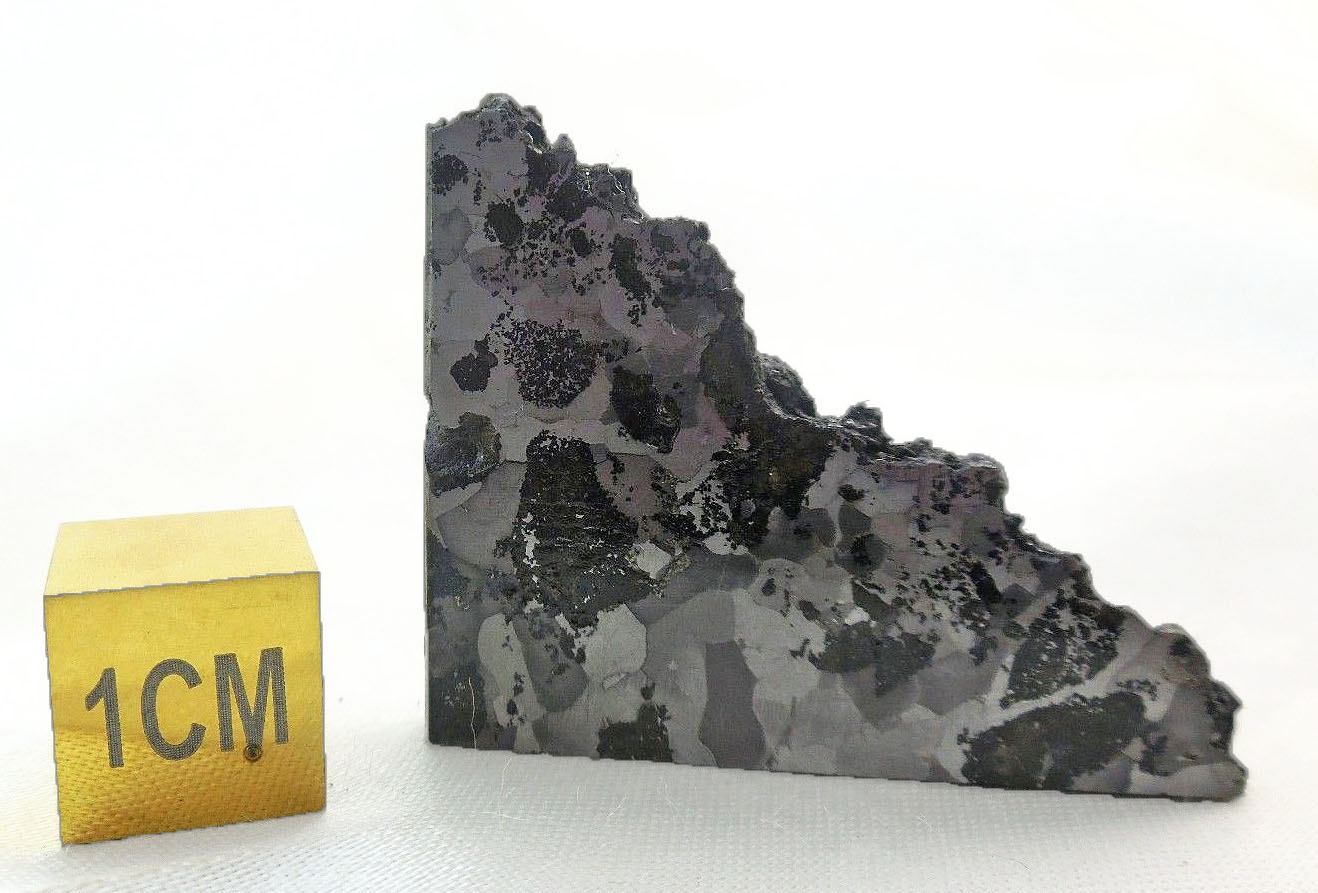|
Roll Overs:
#1
#2
#3
#4
|

|
|
Photos by Jay Piatek.
|
10.83 grams. Iron, IAB-MG
TKW 20 kg. Fall not observed. Found 1863, Atacama, Chile.
  
John writes:
Copiapo is from the IAB main group of iron meteorites, and its history is riddled with misunderstandings and inaccuracies.
In 1863 a three pound rounded specimen of iron was sent to mineralogist Wilhelm von Haidinger in Austria along with a collection of minerals uncovered from a silver mine near Atacama, Chile. Why this specimen was sent to an Austrian mineralogist from Chile is somewhat unclear, but it may be due to what was, at the time, a large immigration of Western Flemish citizens to the Chilean state. The specimen was cut into three masses and studied via galvanic prints of the etched surfaces to form a preliminary description of the meteorite.
Shortly after, in 1868, two additional specimens of 1305g and 80g were sent to mineralogist Gabriel Auguste Daubree in Paris from Ignacy Domekyo, a Polish geologist and mineralogist living in Chile and acting at the time as the General Inspector of Mines. Daubree also formed a preliminary description of the specimens, but accidentally mislabeled the specimens as Dehesa, which is another iron meteorite originating instead from Santiago, Chile. The mix up occurred because both meteorite specimens were in the same parcel, and both appear structurally similar to the naked eye. This error occurred along with an error in the weight of one of the Copiapo specimen. Originally the 80g specimen was labeled 800g. These errors were later cleared up by Domekyo in 1889, but not before resulting in years worth of confusion concerning the two specimens.
In 1884 the 1328g main mass of the Corrizatillo IAB-complex meteorite was sent from Santiago, Chile to Oslo University for study. This meteorite was provisionally thought to be a specimen of Copiapo, and was labeled as such. The region of Carrizalillo, Chile (spelled with an “l” not a “t”) is the actual location of the find for the Corizatillo (“t”) meteorite, but Carrizalillo (“l”) is also one of the various discredited synonyms for the Vaca Muerta meteorite find from 1861. For this reason the meteorite specimen found in Corrizalillo (“l”) is referred to as Corrizatillo (“t”), and in the wake of all this Copiapo was for a time mistaken to be a portion of Vaca Muerta.
The pattern of Copiapo specimens with uncertain origins coming to European mineralogists did not end there. In 1898 Meunier in Paris published the arrival of another lot of specimens totaling of 13.9kg, the largest specimen within it having a mass of 9.5kg. In 1906 Klein in Berlin published the arrival of another 3.4kg. The exact origin point of all these specimens were unclear, but they all appeared to be the same material coming from the same region.
All this mess being left in the past, the total known weight rests at 20kg, and the official locality is designated as Atacama, Chile.
This specimen was taken from the “front” tip of Jay Piatek’s 115g end cut specimen, (shown in the last photo) which was itself acquired from Bob Haag.
Resources:
Catalogue of Meteorites
Cambridge University Press
Handbook of Iron Meteorites, Buchwald
Metbase information courtesy of Jay Piatek
Photos courtesy of Jay Piatek" |
Click to view larger photos
#1
#2
#3
#4
|
Found at the arrow (green or red) on the map below
|
|
| |
MexicoDoug
3/16/2016 8:43:23 AM |
Thanks for taking the time for a great write-up and sharing the pics. The history of this meteorite in space is probably no less confusing compared to its peers with odd features giving a stained glass appearance of the slice to me! Sharp! |
Graham Macleod
2/18/2016 5:26:52 PM |
Wow John,
This is a new one for me but it is great!
Your description is great and explains a lot of it's history.
Thanks John |
John Divelbiss
2/17/2016 12:19:36 PM |
Nicely distributed silicate patches...the type must be rare? |
John Hope
2/17/2016 1:19:14 AM |
Thanks Big John for a great combined effort from you and Jay. Great photo's and info. |
| |
|